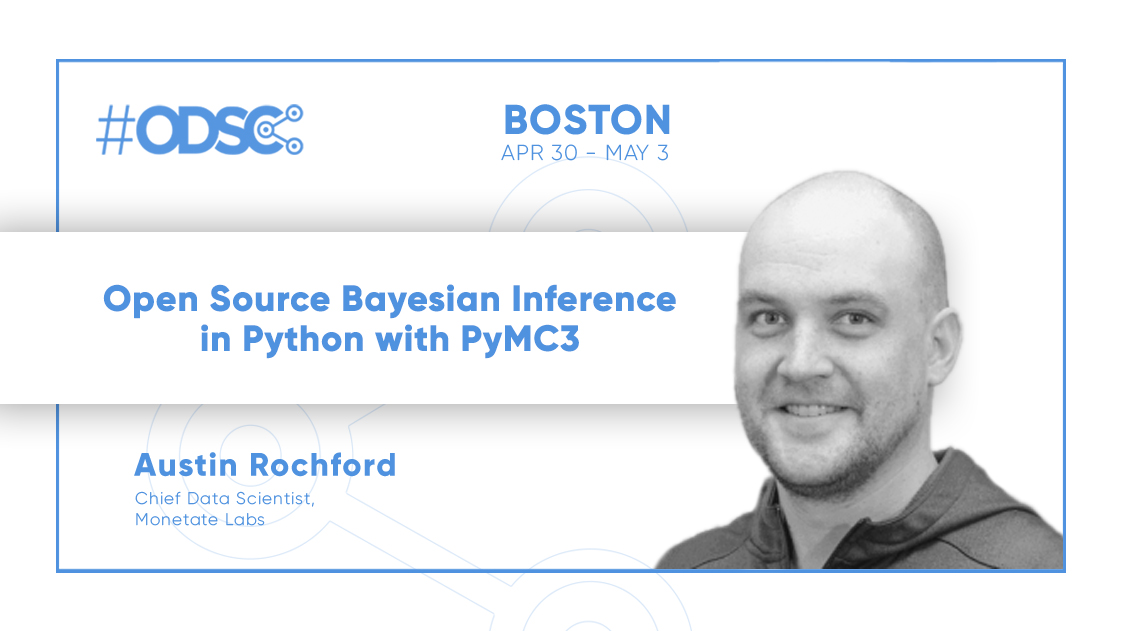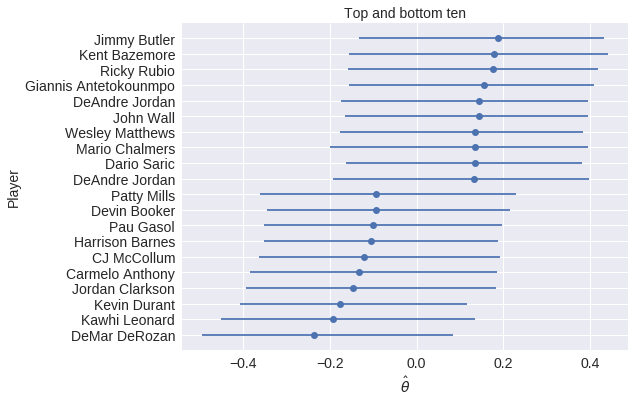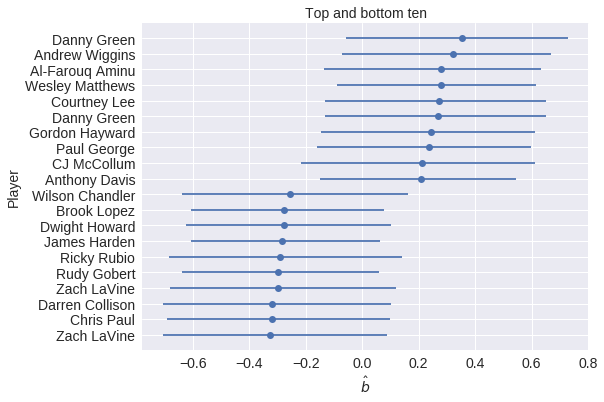
Who am I?¶

PyMC3 developer • Chief Data Scientist @ Monetate¶
@AustinRochford • Website • GitHub¶
arochford@monetate.com • austin.rochford@gmail.com¶
About This Talk¶
About Monetate¶

- Founded 2008, web optimization and personalization SaaS
- Observed 6.2B impressions and $4.1B in revenue during Cyber Week 2018
Modern Bayesian Inference¶


Player skills(?)¶

 |
 |
Probabilistic Programming — storytelling enables inference

The Monty Hall Problem¶

Initially, we have no information about which door the prize is behind.
import pymc3 as pm
with pm.Model() as monty_model:
prize = pm.DiscreteUniform('prize', 0, 2)
If we choose door one:
| Prize behind | Door 1 | Door 2 | Door 3 |
|---|---|---|---|
| Door 1 | No | Yes | Yes |
| Door 2 | No | No | Yes |
| Door 3 | No | Yes | No |
from theano import tensor as tt
with monty_model:
p_open = pm.Deterministic(
'p_open',
tt.switch(tt.eq(prize, 0),
np.array([0., 0.5, 0.5]), # it is behind the first door
tt.switch(tt.eq(prize, 1),
np.array([0., 0., 1.]), # it is behind the second door
np.array([0., 1., 0.]))) # it is behind the third door
)
Monty opened the third door, revealing a goat.

with monty_model:
opened = pm.Categorical('opened', p_open, observed=2)
Should we switch our choice of door?
with monty_model:
monty_trace = pm.sample(1000, **MONTY_SAMPLE_KWARGS)
monty_df = pm.trace_to_dataframe(monty_trace)
Multiprocess sampling (3 chains in 3 jobs) Metropolis: [prize] Sampling 3 chains: 100%|██████████| 4500/4500 [00:01<00:00, 3643.12draws/s]
monty_df['prize'].head()
0 0 1 0 2 0 3 0 4 1 Name: prize, dtype: int64
ax = (monty_df['prize']
.value_counts(normalize=True, ascending=True)
.plot(kind='bar', color='C0'))
ax.set_xlabel("Door");
ax.yaxis.set_major_formatter(pct_formatter);
ax.set_ylabel("Probability of prize");

From the PyMC3 documentation:
PyMC3 is a Python package for Bayesian statistical modeling and Probabilistic Machine Learning which focuses on advanced Markov chain Monte Carlo and variational fitting algorithms. Its flexibility and extensibility make it applicable to a large suite of problems.
Monte Carlo Methods¶
N = 5000
x, y = np.random.uniform(0, 1, size=(2, N))
fig
in_circle = x**2 + y**2 <= 1
fig
4 * in_circle.mean()
3.1335999999999999
History of Monte Carlo Methods¶

Case Study: NBA Foul Calls¶

Question: Is (not) committing and/or drawing fouls a measurable player skill?
orig_df.head(n=2).T
| play_id | 20150301CLEHOU-0 | 20150301CLEHOU-1 |
|---|---|---|
| period | Q4 | Q4 |
| seconds_left | 112 | 103 |
| call_type | Foul: Shooting | Foul: Shooting |
| committing_player | Josh Smith | J.R. Smith |
| disadvantaged_player | Kevin Love | James Harden |
| review_decision | CNC | CC |
| away | CLE | CLE |
| home | HOU | HOU |
| date | 2015-03-01 00:00:00 | 2015-03-01 00:00:00 |
| score_away | 103 | 103 |
| score_home | 105 | 105 |
| disadvantaged_team | CLE | HOU |
| committing_team | HOU | CLE |
Model outline¶
$$ \operatorname{log-odds}(\textrm{Foul}) \ \sim \textrm{Season factor} + \left(\textrm{Disadvantaged skill} - \textrm{Committing skill}\right) $$
with pm.Model() as irt_model:
β_season = pm.Normal('β_season', 0., 2.5, shape=n_season)
θ = hierarchical_normal('θ', n_player) # disadvantaged skill
b = hierarchical_normal('b', n_player) # committing skill
p = pm.math.sigmoid(
β_season[season] + θ[player_disadvantaged] - b[player_committing]
)
obs = pm.Bernoulli(
'obs', p,
observed=df['foul_called'].values
)
Metropolis-Hastings Inference¶
with irt_model:
step = pm.Metropolis()
met_trace = pm.sample(5000, step=step, **SAMPLE_KWARGS)
Multiprocess sampling (3 chains in 3 jobs) CompoundStep >Metropolis: [σ_b] >Metropolis: [Δ_b] >Metropolis: [σ_θ] >Metropolis: [Δ_θ] >Metropolis: [β_season] Sampling 3 chains: 100%|██████████| 16500/16500 [01:33<00:00, 176.67draws/s] The gelman-rubin statistic is larger than 1.4 for some parameters. The sampler did not converge. The estimated number of effective samples is smaller than 200 for some parameters.

trace_fig
max(np.max(var_stats) for var_stats in pm.gelman_rubin(met_trace).values())
3.1038666861280597
The Curse of Dimensionality¶
This model has
n_param = n_season + 2 * n_player
n_param
948
parameters
fig
Automating calculus¶

$$\frac{d}{dx} \left(x^3\right) = 3 x^2$$
x = tt.dscalar('x')
x.tag.test_value = 0.
y = x**3
pprint(tt.grad(y, x))
'((fill((x ** TensorConstant{3}), TensorConstant{1.0}) * TensorConstant{3}) * (x ** (TensorConstant{3} - TensorConstant{1})))'
Case Study Continued: NBA Foul Calls¶
with irt_model:
nuts_trace = pm.sample(500, **SAMPLE_KWARGS)
Auto-assigning NUTS sampler... Initializing NUTS using jitter+adapt_diag... Multiprocess sampling (3 chains in 3 jobs) NUTS: [σ_b, Δ_b, σ_θ, Δ_θ, β_season] Sampling 3 chains: 100%|██████████| 3000/3000 [02:02<00:00, 24.59draws/s]
nuts_gr_stats = pm.gelman_rubin(nuts_trace)
max(np.max(var_stats) for var_stats in nuts_gr_stats.values())
1.0069298341016355
fig
Basketball strategy leads to more complexity¶

fig
Next Steps¶
PyMC3¶
|
|

|

|
Probabilistic Programming Ecosystem¶

Hamiltonian Monte Carlo¶
 A Conceptual Introduction to Hamiltonian Monte Carlo
A Conceptual Introduction to Hamiltonian Monte Carlo











